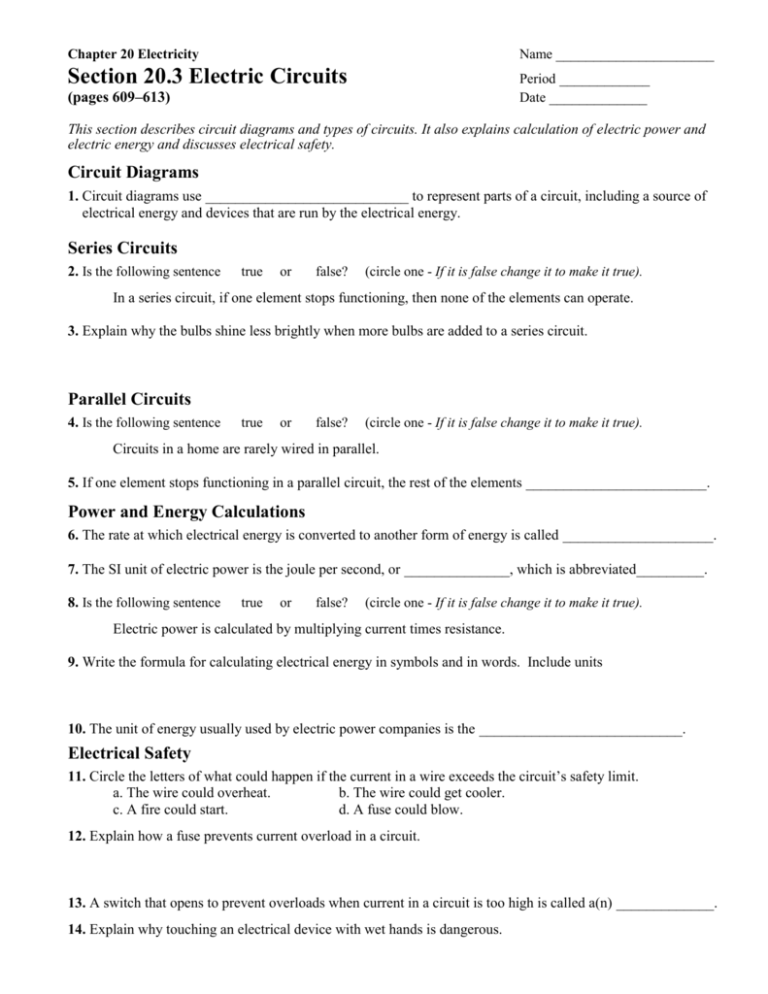Chapter 12 Forces and Motion
advertisement

Chapter 20 Electricity Name _____________________ Section 20.3 Electric Circuits Period ____________ Date _____________ (pages 609–613) This section describes circuit diagrams and types of circuits. It also explains calculation of electric power and electric energy and discusses electrical safety. Circuit Diagrams 1. Circuit diagrams use ___________________________ to represent parts of a circuit, including a source of electrical energy and devices that are run by the electrical energy. Series Circuits 2. Is the following sentence true or false? (circle one - If it is false change it to make it true). In a series circuit, if one element stops functioning, then none of the elements can operate. 3. Explain why the bulbs shine less brightly when more bulbs are added to a series circuit. Parallel Circuits 4. Is the following sentence true or false? (circle one - If it is false change it to make it true). Circuits in a home are rarely wired in parallel. 5. If one element stops functioning in a parallel circuit, the rest of the elements ________________________. Power and Energy Calculations 6. The rate at which electrical energy is converted to another form of energy is called ____________________. 7. The SI unit of electric power is the joule per second, or ______________, which is abbreviated_________. 8. Is the following sentence true or false? (circle one - If it is false change it to make it true). Electric power is calculated by multiplying current times resistance. 9. Write the formula for calculating electrical energy in symbols and in words. Include units 10. The unit of energy usually used by electric power companies is the ___________________________. Electrical Safety 11. Circle the letters of what could happen if the current in a wire exceeds the circuit’s safety limit. a. The wire could overheat. b. The wire could get cooler. c. A fire could start. d. A fuse could blow. 12. Explain how a fuse prevents current overload in a circuit. 13. A switch that opens to prevent overloads when current in a circuit is too high is called a(n) _____________. 14. Explain why touching an electrical device with wet hands is dangerous. 15. Is the following sentence true or false? (circle one - If it is false change it to make it true). A ground-fault circuit interrupter shuts down the circuit if the current flowing through the circuit and current returning to ground are equal. 16. The transfer of excess charge through a conductor to Earth is called ___________________________. Math Practice 17. A stereo receiver uses a current of 2.2 amps from a 120-volt line. What is its power? Given Formula Solution 18. The power rating on an electric oven is 9300 watts. If the oven is plugged into a 240-volt line, how much current does it use? What is the resistance of the oven? Given Formula Solution Critical Thinking 19. Two bulbs connected in parallel shine more brightly than when they are connected to the same voltage source in series. If the voltage is the same, and the resistance of the individual bulbs didn’t change, why does this happen? Explain why this doesn’t violate the law of conservation of energy. 20. Explain why it would be advantageous if your Christmas lights were connected in parallel instead of series. 21. If you plug in a toaster at home and turn it on and the lights go out in several rooms, what has probably happened and what can be done to fix it? 22. Your hair dryer has a high-heat setting and a low-heat setting. Using your formula for electric power and Ohm’s law, what do you think is true about the resistance of each setting. Explain your answer completely.






